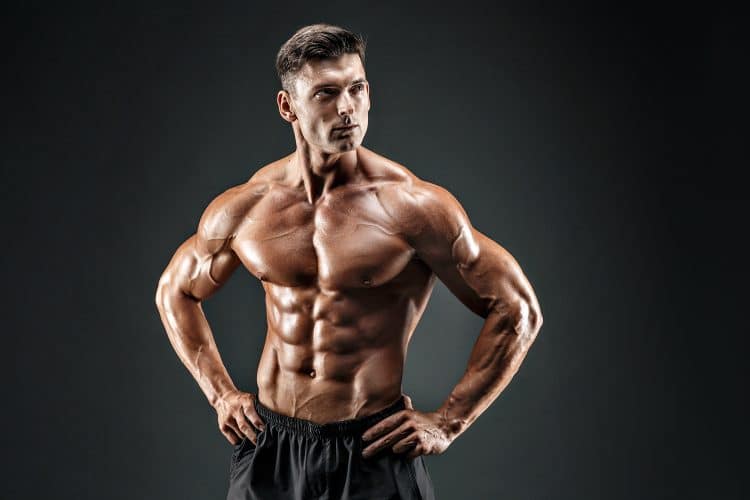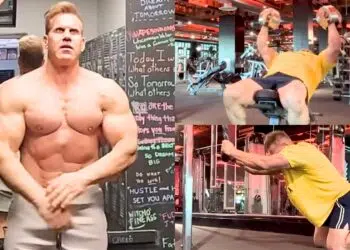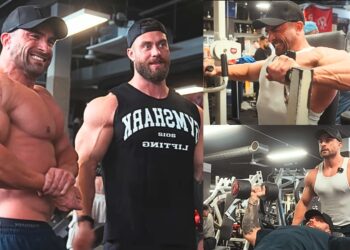As a personal trainer with over 30 years of experience, it’s my job to help my clients avoid training plateaus and keep making progress – right the way up to their genetic potential.
After all, the reason many of my clients hire me is because they want to tap into my three decades of practical and theoretical know-how!
In some cases, maintaining progress is as much about nutrition and lifestyle as it is about training. Your out-of-the-gym habits can have a huge impact on your results, such as getting enough sleep, or consuming sufficient protein.
However, in other cases, the best way to bust out of a training rut is with a new workout or training plan. That’s where my years of experience really come into play. I’ve researched and tried dozens of different training methods, so I have a library of options to call on.
In this article, I’m going to share an unconventional three-workout chest routine that’s guaranteed to reignite pec growth. It’s different to what you are probably used to, but that’s why it’s going to work!
What’s Wrong with Your Current Chest Workout?
If like most bodybuilders, you train your chest once a week, the reason for your plateau is already pretty clear – workout frequency and training intensity are too low.
Level Up Your Fitness: Join our 💪 strong community in Fitness Volt Newsletter. Get daily inspiration, expert-backed workouts, nutrition tips, the latest in strength sports, and the support you need to reach your goals. Subscribe for free!
Low frequency + high volume = low intensity + poor results!
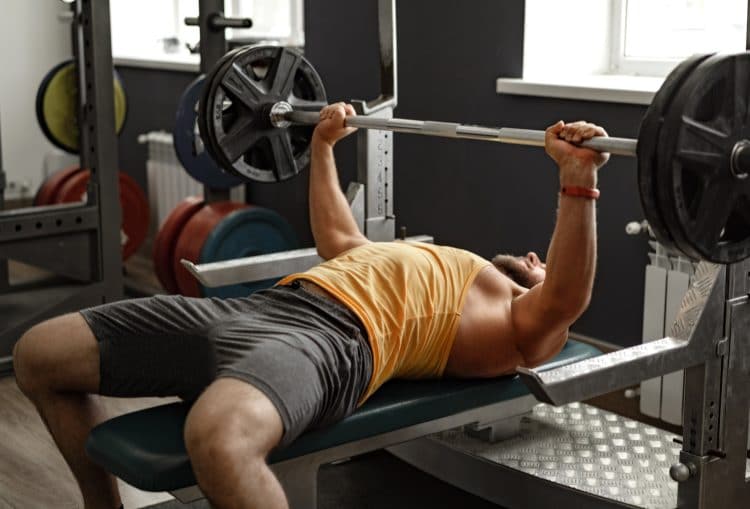
Muscles generally take 48-72 hours to recover from a workout. Once recovery has occurred, your muscles are ready to train again.
But, if you only work your chest once a week (168 hours), that means you are not stimulating your muscles often enough to produce maximal gains. In fact, you’re actually detraining between workouts instead of making progress.
Also, once-a-week chest training invariably involves a lot of exercises and sets – a low-frequency, high-volume approach.
The more volume you do, the less intense your workout becomes, but the more fatigue you accumulate. Getting tired doesn’t make your muscles grow – exposure to ever-increasing degrees of muscle tension is the trigger for hypertrophy.
You can train long, or you can train hard, but you can’t do both.
For example, maybe your current chest workout currently looks something like this:
- Bench press 4 sets of 8 reps
- Incline dumbbell press 4 sets of 8 reps
- Decline bench press 4 sets of 8 reps
- Cable crossovers 3 sets of 10 reps
- Chest press machine 3 sets of 10 reps
- Pec deck 3 sets of 10 reps
- Chest dips 2 sets of AMRAP (max) reps
- Push-ups 2 sets of AMRAP (max) reps
While you have most definitely hit your chest from all the available angles, the intensity will have steadily declined over the course of the workout until, by the end, you are basically just going through the motions.
Your training weights will be light, you won’t manage many reps, and all you are really doing is creating fatigue. You get the greatest hypertrophy stimulus from the first couple of exercises in your workout (1). The last few exercises and sets are basically pointless junk volume.
That’s why most lifters tend to front-load their workouts, doing the most important, demanding exercises at the start and the easier ones near the end. This allows for the accumulating fatigue.
Imagine how much more productive your workout could be if you trained each exercise with maximum intensity…
Also read: High-Frequency, Low-Volume Strength Training
Too many redundant exercises
Look at most bodybuilding workouts, and you’ll see a lot of very similar exercises. Most of this variety is unnecessary. Subtle changes to things like hand position or switching from freeweights to machines makes no real difference to hypertrophy.
Your muscles are pretty dumb – they don’t know if you are doing bench presses or push-ups. They just know tension and work. Providing you work your muscles hard enough, they’ll respond by getting stronger and bigger.
Once they’ve been stimulated, you don’t need to hit them again using an almost identical exercise. There is no additional trigger for growth, and instead, you’re just creating a deeper level of fatigue, so you’ll need longer to recover between workouts.
Doing more than a couple of exercises per muscle group is basically a waste of time and energy.
In contrast, doing fewer exercises and sets means you can raise the intensity of your workout, producing better results while saving your energy for recovery and growth.
Lower training volume also means you can train your muscles more frequently. In studies, more frequent workouts have been shown to be superior for building hypertrophy and strength (2).
Related: 23 Best Chest Exercises to Transform Your Chest, According to a Fitness Coach
Creating a Better Chest Workout
So, if training your chest once a week with a high-volume workout isn’t working, you should do the opposite.
Of course, some genetic freaks (and steroid users) grow like weeds training the “wrong” way, but if you’ve tried the standard approach and failed to get the results you want, it’s time to do something else.
Considering the potential issues with high-volume, low-frequency bodybuilding training, that means:
- 2-3 exercises per chest workout
- Choose very different exercises
- Hit your chest 2-3 times per week
- Train at a high level of intensity, i.e., very close to failure
- Rest a little longer between sets to maximize workout performance
In simple terms, you’ll take your usual chest training volume and spread it out over several shorter workouts. This will allow you to a) train harder and b) hit your chest multiple times each week to produce more hypertrophic (muscle-building) events.
Chest Day Workout Routines
Using the information above, you should be able to create your own unconventional chest training plan.
But, to save you the bother, we’ve got one for you to try.
Yes, it’s VERY different from what a lot of bodybuilders do, but that’s why it works. Sometimes, the best solution to a problem is doing the opposite.

For this workout plan, you’ll be training your chest three times a week, e.g., Monday, Wednesday, and Friday. The volume is low, so you can take each set to failure.
Don’t be fooled by the brevity of these workouts; you still need to train hard and, more importantly, have to do it again a couple of days later.
Also, bear in mind that instead of doing 15-20 sets for your chest in a single workout, you’ll be doing 18 sets per week, providing more than enough volume for muscle growth. Combined with the increased intensity, this should blast you out of your current chest training rut.
Workout 1
| # | Exercise | Sets | Reps | Recovery |
| 1 | Barbell bench press | 3 | 6-8 | 3 minutes |
| 2 | Incline dumbbell bench press | 2 | 8-12 | 2 minutes |
| 3 | Cable crossovers | 1 | 12-15* | N/A |
*This is your last chest exercise. Make it count by doing a drop set. Rep out to failure, reduce the weight by 10-15%, and rep out again. Lower the weight 2-3 more times to fully exhaust your chest and get a great pump.
Workout 2
| # | Exercise | Sets | Reps | Recovery |
| 1 | Incline barbell bench press | 3 | 6-8 | 3 minutes |
| 2 | Chest dips | 2 | AMRAP | 2 minutes |
| 3 | Pec deck | 1 | 12-15* | N/A |
*This is your last chest exercise. Make it count by doing a drop set. Rep out to failure, reduce the weight by 10-15%, and rep out again. Lower the weight 2-3 more times to fully exhaust your chest and get a great pump.
Workout 3
| # | Exercise | Sets | Reps | Recovery |
| 1 | Dumbbell bench press | 3 | 6-8 | 3 minutes |
| 2 | Decline push-ups | 2 | AMRAP | 2 minutes |
| 3 | Incline dumbbell flys | 1 | 12-15* | N/A |
*This is your last chest exercise. Make it count by doing a drop set. Rep out to failure, reduce the weight by 10-15%, and rep out again. Lower the weight 2-3 more times to fully exhaust your chest and get a great pump.
Chest Anatomy
Do you need to be an expert in pec anatomy to build a chest to be proud of? Probably not! But it is useful to understand these basics so you can choose the best exercise for sculpting the chest of your dreams.
The pectoralis major, or pecs for short, is a large, thick, fan-shaped muscle located on the upper part of your chest. Its name comes from the Latin word pectus, meaning breast.
The pec. major comprises the bulk of your chest mass. The muscle beneath, pectoralis minor, is much thinner and doesn’t contribute much to chest size.
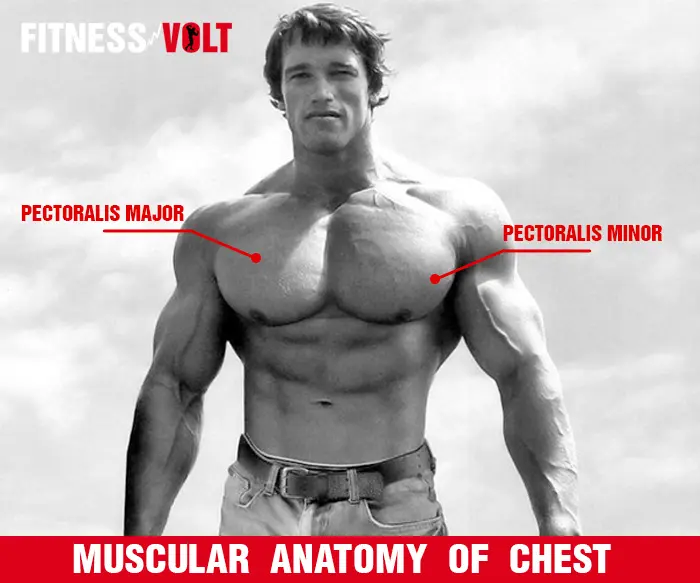
The pectoralis major is a convergent muscle with three broad attachment sites that come together at a single insertion point. It can be divided into two sections or heads – the clavicular or upper head, and the sternal or lower head. The sternal head is also known as the abdominal head.
The functions of the pectoralis major are…
The Clavicular head:
- Shoulder flexion
- Horizontal adduction
- Internal rotation
The Sternal head:
- Shoulder extension
- Horizontal adduction
- Internal rotation
The clavicular head or upper pecs are most active during incline chest exercises. In contrast, the sternal or lower pecs are engaged more during decline movements.
Consequently, you must include flat, incline, and decline exercises in your workouts to develop the pecs fully. That’s why you’ll see three angles in the workouts featured in this article.
How To Make Your Workouts Even More Effective
I’ve tried and tested this chest-building routine with numerous clients, and in every case, it’s produced great results.
Level Up Your Fitness: Join our 💪 strong community in Fitness Volt Newsletter. Get daily inspiration, expert-backed workouts, nutrition tips, the latest in strength sports, and the support you need to reach your goals. Subscribe for free!
However, I’m pretty greedy when it comes to gains and want to help you make the best possible progress with any of my workouts.
So, to that end, here are some tips and tricks for making your pec-pumping workouts even more effective!
1. Lower slowly, lift fast
You are stronger eccentrically than you are concentrically. In other words, you can lower more weight than you can lift. While you can’t vary the load during your reps, you can make parts of your rep harder to reflect this phenomenon.
Simply perform the eccentric or lowering phase of each rep slowly, and then lift the load explosively. This ensures each rep is as stimulating as possible. For example, lower for three seconds and lift in one second.
2. Pause in the stretched position
Studies show us that weighted stretches can produce significant gains in hypertrophy (4). You can make use of this information by pausing in the stretched position of some of your reps.
For example, during dumbbell bench presses, lower the weights as far as you can and then pause for 2-3 seconds. This should enhance muscle growth.
You can combine this tip with the previous one by lowering the weight in 2-3 seconds, pausing for 2-3 seconds, and then lifting the load as quickly as you can.
3. Try stretching your pecs between sets
While this is a somewhat controversial concept, some studies suggest that stretching between sets may enhance hypertrophy (5).
To experiment with this concept, simply stretch your pecs for 20-30 seconds between sets of strength training. However, if you find inter-set stretching makes you weaker, then this training method is not for you.
4. Use a full range of motion
It can be tempting to reduce your range of motion (ROM) when lifting heavy weights. After all, shorter reps are usually easier than full reps. For example, you can do half-rep bench presses with more weight than you can lift with full-range reps.
However, this is ego-lifting and best avoided. You’ll get better hypertrophic results from full ROM reps.
So, make sure you lift and lower the weights as far as is practical and safe. This will make your workout harder, but when it comes to building muscle, harder is invariably better!
5. Make your workouts progressive
If you want your muscles to grow, you need to challenge them. While one tough workout will get the ball rolling, your next workout needs to be a little harder if you want to maintain your progress. You can do this by:
- Lifting more weight
- Doing more reps
- Taking shorter breaks between sets
it really doesn’t matter how you do it, so long as you strive to make each workout harder than the last. That said, never sacrifice good form for an extra rep or more weight on the bar, as that’s a recipe for injury.
Instead, make sure you progress safely, and not by being driven by your ego!
6. Pay as much attention to your lifestyle as you do your workouts
Training is only part of the muscle-building equation, and what you do outside of the gym is as important as what you do in it. Factors you MUST consider include:
- Diet
- Rest
- Sleep
- Stress
- Mindset
- Supplements
If you neglect any of these things, your progress won’t be as good as it could have been. So, pay as much attention to your lifestyle as you do your workouts if you want to maximize your gains.
7. Strengthen your mind-muscle connection
You won’t develop your best-ever chest if you cannot control it. It’s not enough to mindlessly pump out reps of bench presses or push-ups – you need to really FEEL the muscles working.
Bodybuilders call this the mind-muscle connection.
Many exercisers sacrifice their mind-muscle connection when they try and lift more weight than usual or pay too little attention to their form. Needless to say, this can have a detrimental effect on your progress.
Instead, you should feel your pecs working from your first rep to your last, even when you’re warming up.
Master your mind-muscle connection to get the most from every exercise you do.
Chest Day Workout Routine FAQs
1. A lot of champion bodybuilders train their chests once per week, so why can’t I?
Most elite bodybuilders use steroids. Steroids increase protein synthesis, which means drug-using bodybuilders are in an almost constant state of anabolism, and even the “wrong” workout will produce the right results.
Training like a steroid-using pro won’t work for natural lifters because your body is not in the same 24/7 anabolic state. Natural lifters usually do better on shorter, more frequent workouts.
2. Are 1-3 sets really enough for muscle growth?
Studies have shown that one set is enough to trigger hypertrophy providing that you train to failure or close to it. However, doing 2-3 sets will produce better results. More than three sets won’t lead to much more muscle growth but will create more fatigue, which means you won’t be able to train as often.
Providing you accumulate between 10-20 sets per muscle group per week, you should get good hypertrophic results from a more frequent approach to training (3).
3. Is this a bulking or cutting workout?
The main difference between cutting and bulking is your diet rather than the workout you are following. For example, if you eat 300-500 calories above your TDEE (Total Daily Energy Expenditure), you should bulk up and build muscle.
In contrast, if you reduce your calorie expenditure to 300-500 calories BELOW your TDEE, you should burn fat and get leaner.
So, adjust your diet according to your body composition goal. Eat more to build muscle and less to lose fat. Train hard to stimulate muscle growth or preserve your existing muscle mass during your cutting diet.
4. Can I change the exercises?
Providing you use similar exercises, you are free to make changes to the programs. However, don’t increase training volume or use different rep ranges.
The idea is to train with heavy weights for maximal muscle tension (exercise 1), moderate weights to create plenty of metabolic stress (exercise 2), and then moderate progressing to light weights to fatigue as many muscle fibers as possible (exercise 3).
Providing you stick with that format, changing exercises should have no real effect on your progress.
Pick exercises from our library of best chest exercises to make sure your workout is as productive as possible.
5. What does training to failure mean?
Training to failure means doing as many reps as possible with good form. This is also known as technical failure.
You’ll know you are approaching failure when your repetition speed starts to decrease, and you feel you need to take longer pauses between reps. Your facial expression will also change, and you’ll start to grimace. In short, you should feel that you cannot do any more reps without getting assistance from a spotter.
6. How long should I do this workout for?
Stick with this workout for 6-8 weeks, or until you feel it is no longer productive. During that time, do your best to use more weight, do more reps, or just do each set with a higher degree of technical proficiency. These “micro progressions” are what keep your muscles growing.
Then, when you are ready for a new workout, use a similar approach but using mostly new exercises. Alternatively, revert to a lower-frequency, higher-volume chest program for a few weeks before returning to this workout.
7. I’m super sore after doing the first workout – is it okay to train again so soon?
Muscle soreness is simply a sign that you’ve done something new and isn’t necessarily an indicator that anything is wrong or that you haven’t recovered from your last workout. In this case, soreness is probably the result of doing six high-intensity sets when you are used to higher volume but lower-intensity training.
If you are sore, spend a little extra time warming up and do 2-3 ramped sets of the first exercise to ease yourself into your workout.
For example:
- 20 reps (empty barbell)
- 12 reps 40kg/90lbs
- 8 reps 60kg/135lbs
- 3 reps 80kg/175lbs
- 6 reps 100kg/220lbs (1stwork set)
Soreness should become less of an issue as you become accustomed to this new style of training.
Read more about dealing with post-workout muscle soreness here.
Chest Day Wrapping Up
If you are making gains with a more traditional chest workout, then you should continue doing it. After all, if it ain’t broke, don’t fix it.
But, if you are training hard and not seeing the results you want, it’s time to try a different approach. Doing more of the same is not the answer.
Use this workout to see how your chest responds to low-volume, high-frequency training. If it works for your chest, you can use a similar method for all your muscle groups.
References:
- Krieger JW. Single vs. multiple sets of resistance exercise for muscle hypertrophy: a meta-analysis. J Strength Cond Res. 2010 Apr;24(4):1150-9. doi: 10.1519/JSC.0b013e3181d4d436. PMID: 20300012.
- Schoenfeld BJ, Ogborn D, Krieger JW. Effects of Resistance Training Frequency on Measures of Muscle Hypertrophy: A Systematic Review and Meta-Analysis. Sports Med. 2016 Nov;46(11):1689-1697. doi: 10.1007/s40279-016-0543-8. PMID: 27102172.
- Schoenfeld BJ, Ogborn D, Krieger JW. Dose-response relationship between weekly resistance training volume and increases in muscle mass: A systematic review and meta-analysis. J Sports Sci. 2017 Jun;35(11):1073-1082. doi: 10.1080/02640414.2016.1210197. Epub 2016 Jul 19. PMID: 27433992.
- Warneke K, Lohmann LH, Lima CD, Hollander K, Konrad A, Zech A, Nakamura M, Wirth K, Keiner M, Behm DG. Physiology of Stretch-Mediated Hypertrophy and Strength Increases: A Narrative Review. Sports Med. 2023 Nov;53(11):2055-2075. doi: 10.1007/s40279-023-01898-x. Epub 2023 Aug 9. PMID: 37556026; PMCID: PMC10587333.
- Schoenfeld BJ, Wackerhage H, De Souza E. Inter-set stretch: A potential time-efficient strategy for enhancing skeletal muscle adaptations. Front Sports Act Living. 2022 Nov 15;4:1035190. doi: 10.3389/fspor.2022.1035190. PMID: 36457663; PMCID: PMC9706104.
Article Updates Timeline:
Our editorial team experts constantly update the articles with new information & research, ensuring you always have access to the latest and most reliable information.
December 21, 2023
Updated By
Patrick Dale, PT, ex-Marine
Fact Checked By
Dr. Malik
July 21, 2021
Written By
Patrick Dale, PT, ex-Marine

